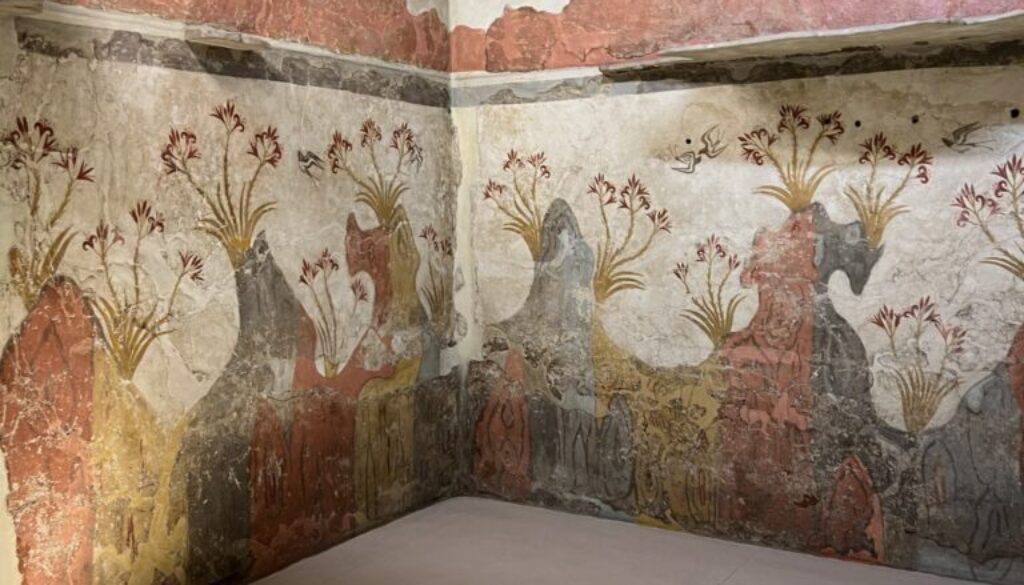Akrotiri Excavation Site, Santorini: A Complete Visitor’s Guide
The Akrotiri Archaeological Site on the island of Santorini, Greece, is one of the most significant ancient sites in the Aegean and an incredible window into the prehistoric past of the Minoan civilization. Often referred to as the “Pompeii of the Aegean” due to its well-preserved remains, Akrotiri is a Bronze Age settlement that was buried under volcanic ash following the massive eruption of Santorini in the 16th century BCE. This ash preserved entire buildings, intricate frescoes, and a wide array of artifacts, offering unparalleled insight into the ancient Aegean’s daily life, trade, art, and architecture.
Brief History and Importance
Akrotiri was a thriving Minoan city at the height of its prosperity when the volcanic eruption of Santorini occurred around 1627 BCE. It is believed that the residents evacuated the site before the eruption, as no human remains have been found at the excavation, though a rich variety of pottery, furniture, and frescoes were left behind. The settlement was quite advanced for its time, with multi-story buildings, an elaborate drainage system, and an organized city plan. It is thought to have been a key maritime and commercial hub that connected the Minoan civilization with other cultures in the Mediterranean.
Archaeological digs began in the late 19th century, but major discoveries were made in 1967 when excavations led by Professor Spyridon Marinatos unearthed much of what visitors see today.
What to Expect at Akrotiri
Today, visitors to Akrotiri can explore a vast covered excavation site. Walkways allow you to see the remains of ancient streets, buildings, and town squares from above, while interpretive signs explain the historical significance of different structures. Some highlights include:
- Three-story buildings that demonstrate the advanced architecture of the time.
- Minoan frescoes, many of which have been relocated to the Museum of Prehistoric Thera, but their original locations are marked on-site.
- A highly developed plumbing and sewage system, which was revolutionary for its time.
- Artifacts such as pottery, tools, and furniture, all preserved in volcanic ash, revealing everyday life in ancient Akrotiri.
How to Get to Akrotiri Excavation Site
Located about 12 km (7.5 miles) from Fira, the capital of Santorini, Akrotiri is easy to access by various means of transportation:
1. Public Buses
- KTEL Santorini Buses regularly service the Akrotiri site from Fira. The journey takes about 20-25 minutes and costs around €2.
- Buses typically run every 30-60 minutes, depending on the season, with more frequent services during the peak tourist months (June to September).
- The bus stop is directly outside the excavation site, making this a convenient and affordable option.
2. Private Tours
- Numerous companies on Santorini offer guided tours to Akrotiri. These tours often include transportation to and from your accommodation and a professional guide who can provide in-depth knowledge of the site.
- Private tours range in price depending on the group size and inclusions. Expect to pay anywhere from €50 to €150 per person for a half-day tour.
- Some tours combine Akrotiri with visits to nearby attractions, such as the Red Beach or local wineries.
3. Rental Cars
- Renting a car is a flexible way to explore Akrotiri and the surrounding area. There are several car rental agencies in Fira, the airport, and throughout the island.
- Parking is available near the site, usually free of charge, though it can get crowded during peak times.
- Rental prices vary, but you can expect to pay around €30 to €50 per day for a small car. Driving on Santorini can be challenging due to narrow roads and heavy traffic during the summer months.
4. Taxis
- Taxis are readily available on the island, and a ride from Fira to Akrotiri costs around €25 to €30. Make sure to agree on the price beforehand, as meters may not always be used.
- You can book taxis in advance through your hotel or use local taxi services.
5. Private Drivers
- For a more comfortable and personalized experience, many visitors opt for private drivers. These drivers are available for hire for half-day or full-day excursions. Prices vary, but typically range from €36 to €60 depending on the duration of the trip.
Nearby Attractions
- Red Beach: Located just a short walk from the Akrotiri site, this beach is famous for its striking red cliffs and volcanic sand.
- The Lighthouse of Akrotiri: is a scenic spot to enjoy the sunset, located a few kilometers from the excavation site.
- Theros Beach: Located on Santorini’s southern coast near Akrotiri, Theros Beach stands out for its dramatic volcanic cliffs, crystal-clear waters, and peaceful atmosphere
Tips for Visiting Akrotiri
- Opening Hours: Akrotiri is open year-round, though hours may vary by season. Typically, it’s open from 8:00 AM to 3:00 PM in the low season and 8:00 AM to 8:00 PM during the high season.
- Admission Fee: The entrance fee is €12 for adults and €6 for reduced tickets (students, seniors). It’s free for children under 18.
- Guided Tours: While you can explore the site on your own, consider hiring a licensed guide or joining a tour to fully appreciate its history and significance.
- Best Time to Visit: Visiting early in the morning or late in the afternoon helps avoid crowds and heat, especially during summer.
Conclusion
The Akrotiri Archaeological Site is a must-visit destination for history lovers and anyone interested in ancient civilizations. Whether you choose to visit via public bus, rental car, or as part of a guided tour, this site offers a unique glimpse into the life of the prehistoric Aegean. Its well-preserved structures and artifacts tell the story of a sophisticated civilization that once thrived on the island of Santorini, making it an unforgettable experience.



